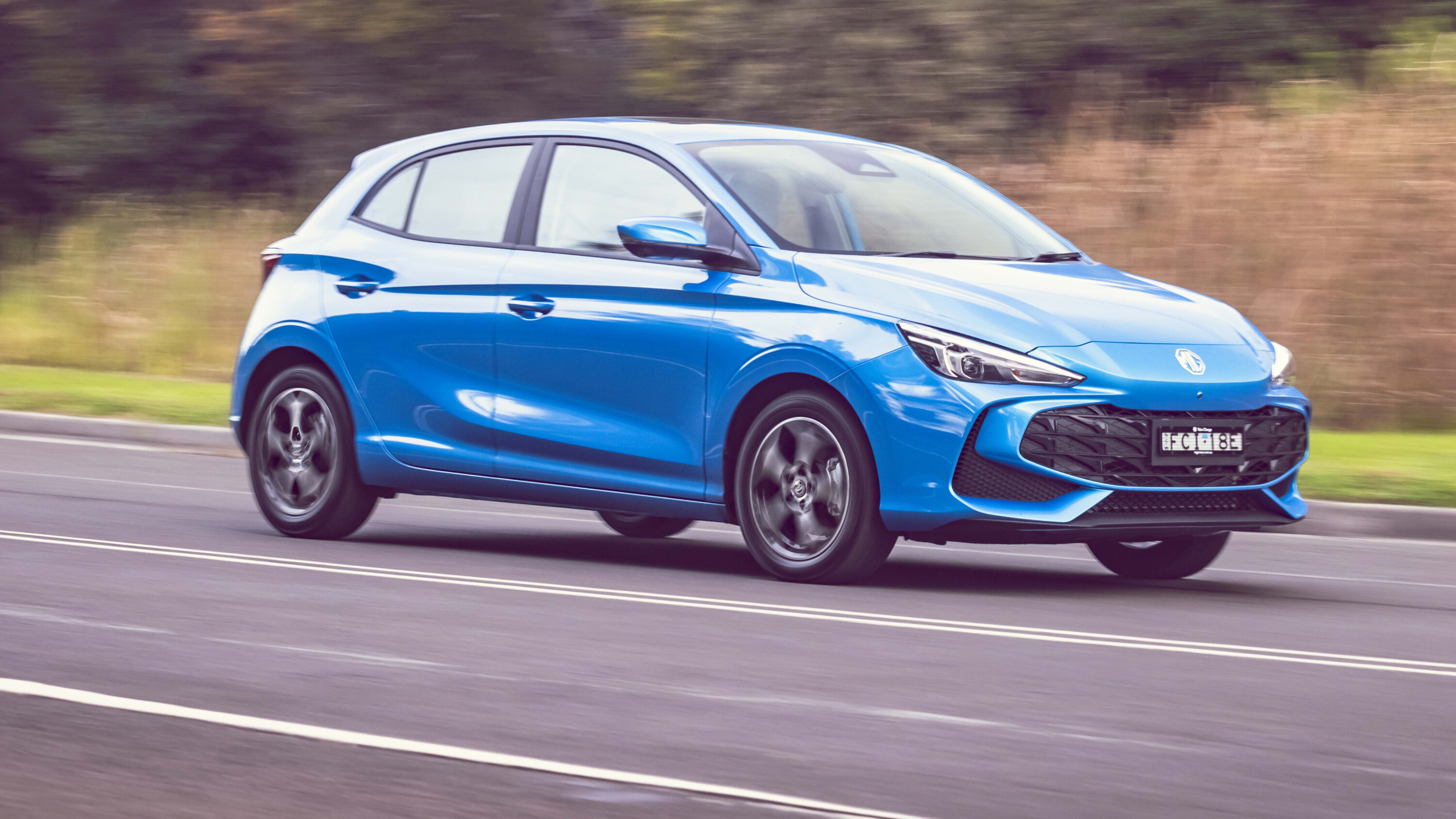Things we like
- Surprisingly brisk performance
- Supple, cushioned ride
- Good interior space for the vehicle size
- Build quality of our test car
- Nimble around town including tight turning circle
Not so much
- Real-world fuel economy higher than expected & premium fuel
- No reach adjustment for steering wheel
- Steering becomes vague at higher speeds
- Jerky and reactive adaptive cruise system
- Speed limit chime
The sub-$20,000 car is dead, long live … well, your best hopes for a brand-new budget car in 2024 and beyond.
MG’s second-generation MG3 has arrived, ousting its predecessor that was the last new car Australians could buy for less than twenty-grand with no more to pay.
Following the Kia Picanto’s move above the $20K drive-away mark earlier this year, the MG3’s starting point climbs steeply from $18,990 drive-away to $23,990 plus on-road charges.

We had been pre-warned, with MG keen to emphasise that the replacement would come standard with significantly more equipment, notably extra safety features that were conspicuous by their absence on the old MG3 (along with a three-star NCAP crash rating).
There’s also a big leap in technology, headlined by MG’s first regular (non-plug-in) hybrid drivetrain.
That inevitably costs more again – a $4000 premium, to be exact, over the standard MG3 models powered by a 1.5-litre four-cylinder petrol engine. The MG4 Hybrid+ starts from $27,990 before on-roads.
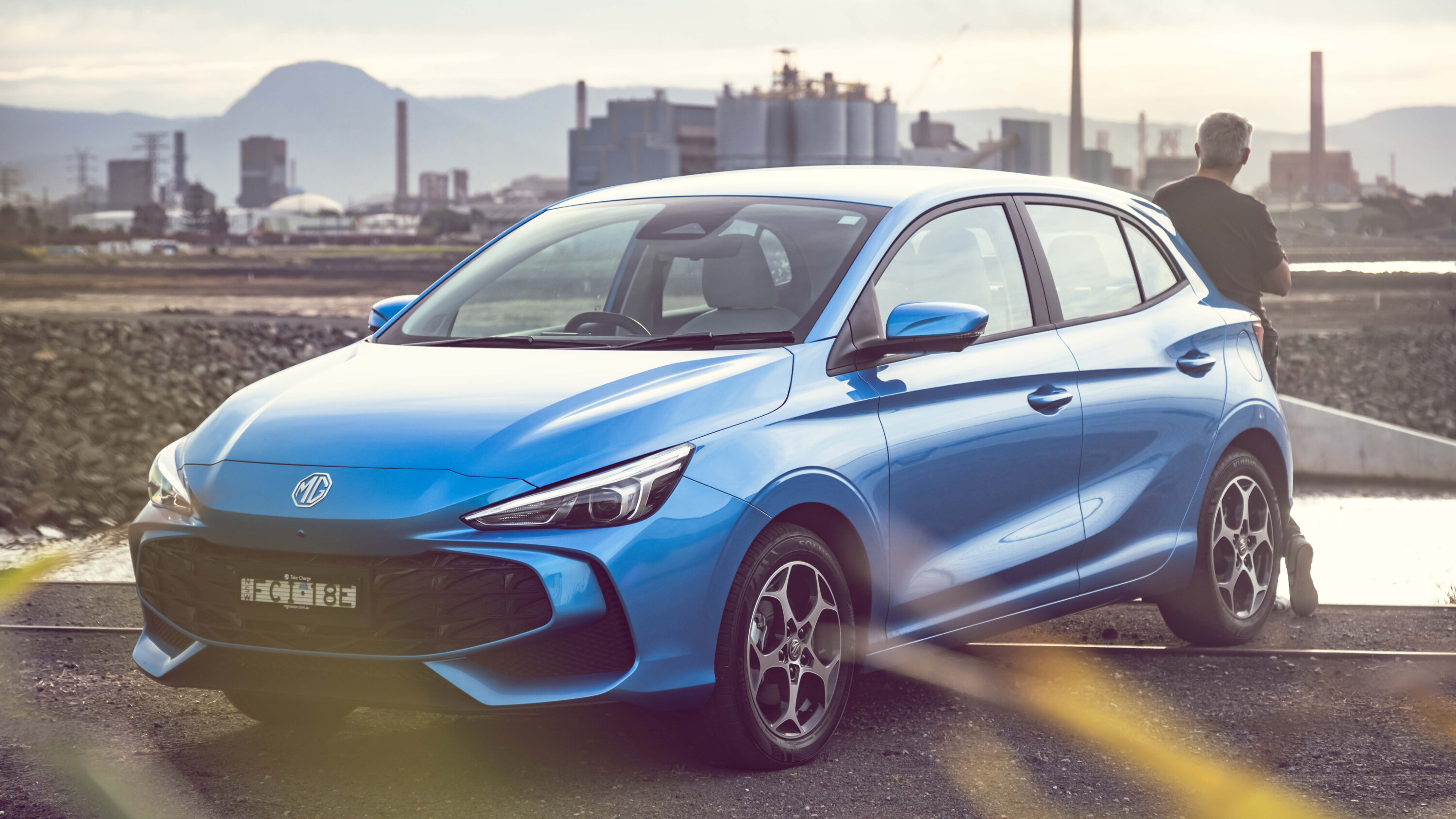
JUMP AHEAD
Pricing and features
Whether petrol or petrol-electric, there are two trim grades familiar to MG showrooms: Excite and Essence.
Safety on the old model is most politely described as elementary, its most advanced driver aids essentially being bread-and-butter ABS and ESC.
Every MG3 now adds the smashed-avo works, incorporating various warning systems (forward collision, lane departure), multi-monitoring (blind spots, rear cross traffic, tyre pressures, “unsteady driver”), and assistance features (adaptive cruise, speed-limit notification, emergency lane keeping).
All models sit on stylish (to our eyes) 16-inch alloys, a size up for entry models, and provide dashboards graced with a digital display combination of central 12.25-inch infotainment screen and 7-inch driver cluster.
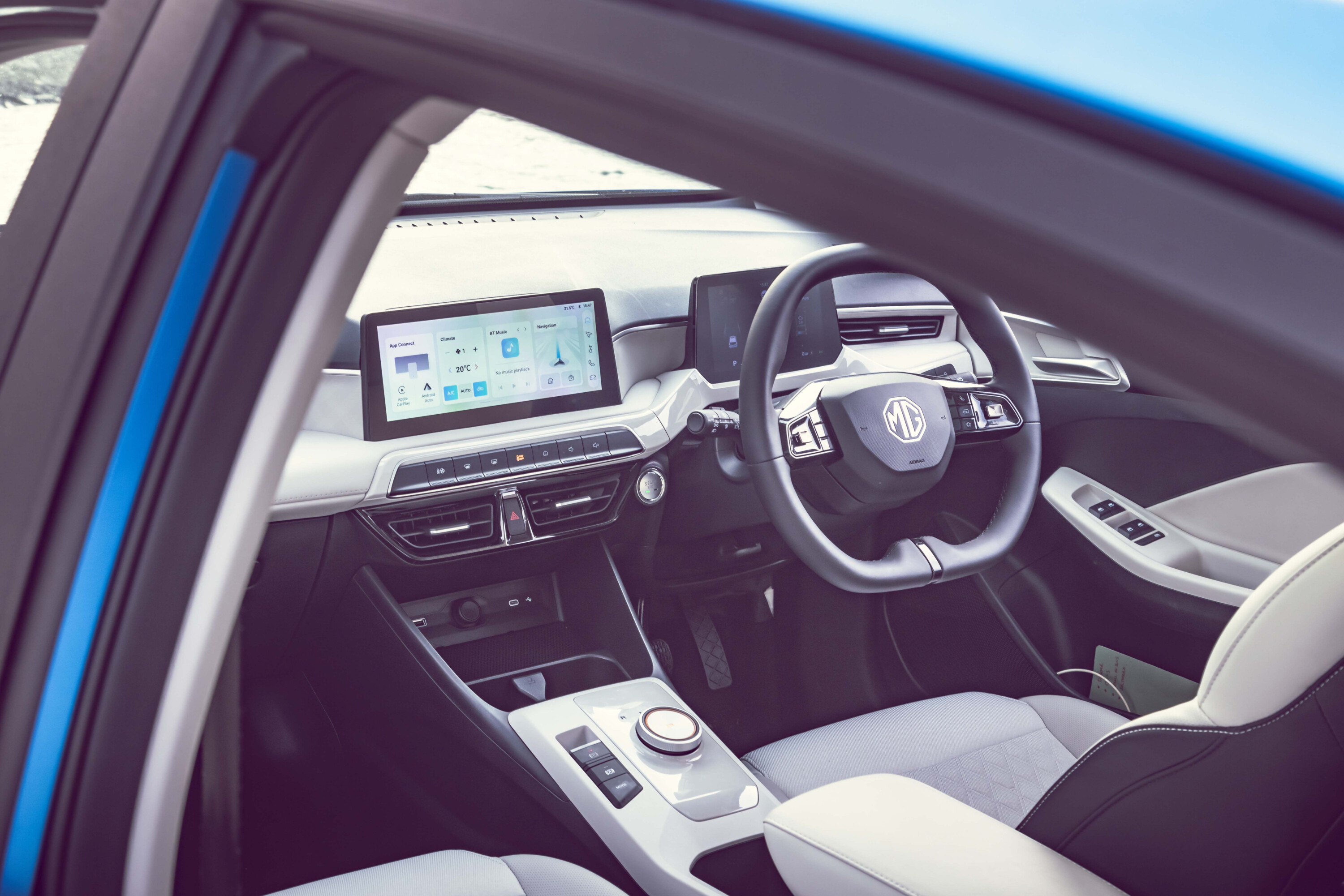
Essence models ramp up tech, materials and convenience to tempt buyers to impart with just an extra $2000.
Starting with the exterior, the headlights switch from halogen to LED, vehicle entry becomes keyless, wipers adopt an auto mode, and the MG3 gains a small sunroof.
Inside, the upholstery changes from cloth to a combination of pleather/fabric, the steering wheel swaps from pleather to real leather, the infotainment system adds navigation and digital radio, and MG throws in a three-year subscription to its iSmart telematics that links various vehicle functions to the owner’s smartphone.
| 2024 MG3 Essence features | |
|---|---|
| 360 camera | Auto wipers |
| LED projector headlights | Keyless entry |
| Sunroof | iSmart compatibility (3yrs) |
| Pleather/cloth seats | Digital radio |
| Leather steering wheel (pleather Excite) | Built in nav |
| 2024 MG3 Excite features | |
|---|---|
| 16-inch alloy wheels | 7-inch driver cluster |
| Halogen headlights | 10.25-inch infotainment |
| LED DRLs | Plug-in Carplay and Auto |
| Cloth seats | Rear vents |
| One-touch windows (driver anti-trap) | Rear USB-A |
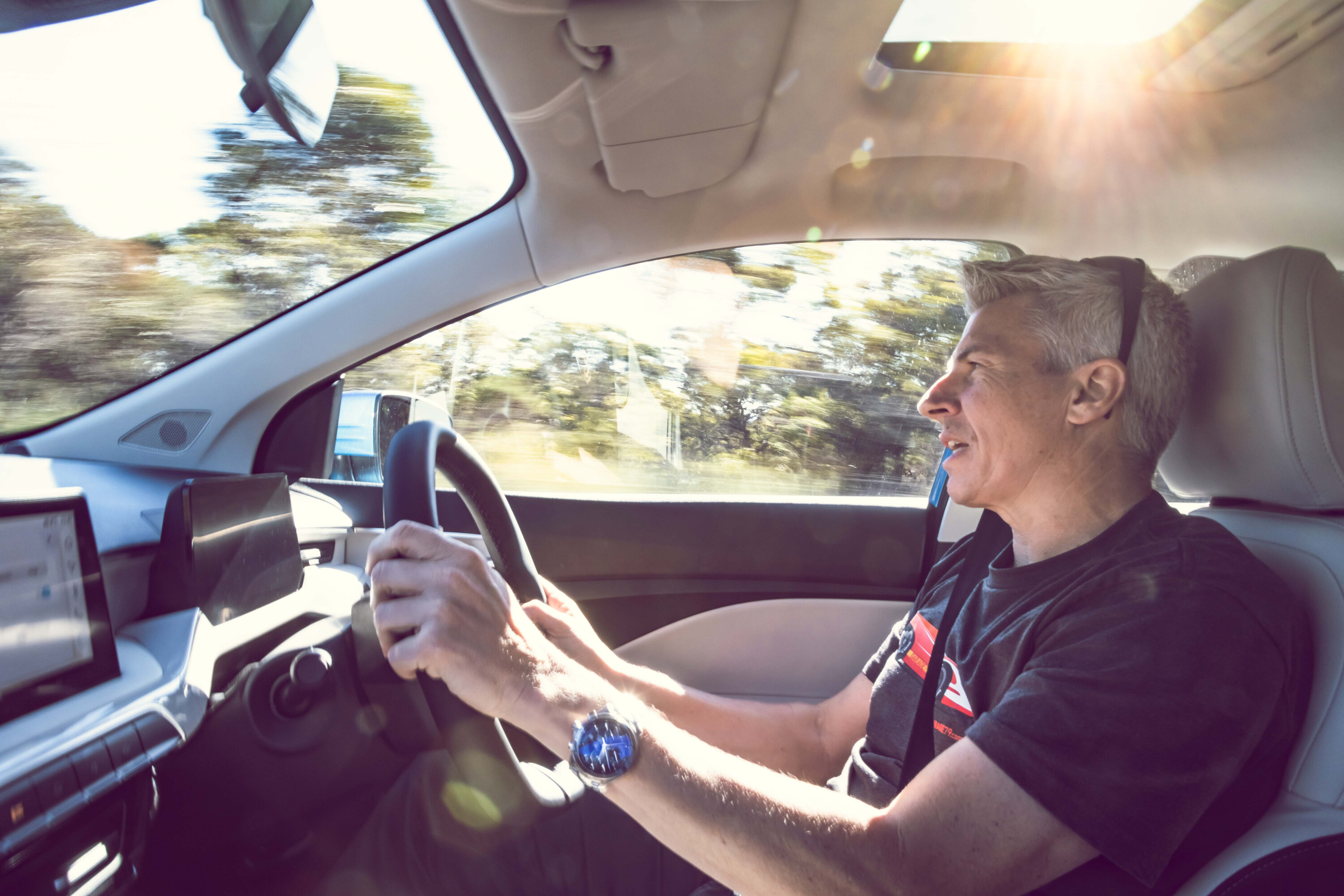
While the Mazda 2 and Volkswagen Polo are technically competitors in what is a severely shrunken city-car class these days, the MG3’s key rivals are the Suzuki Swift, which has also just launched in next-generation form (with a mild-hybrid drivetrain), and the Toyota Yaris that went hybrid-only in early 2024
The MG3 has in recent years outsold both, overtaking the Yaris since 2020, when the tiny Toyota increased its entry price by about $9000. MG Australia will be hoping the MG3’s price increase doesn’t lead to a similar sales fate; last year the Yaris’s 2098 sales were about a fifth of their total in 2019.
It still looks good value compared with the Yaris that has a proper hybrid system, if not as sharply priced as the smaller Swift that is primarily petrol-powered but with partial electric assistance.
Our test car is a best-foot-forward variant, the range-topping Hybrid+ Essence. It’s coated in Brighton Blue (extra-cost) metallic, one of the brighter options alongside a yellow and red in an expanded palette also featuring your staple white, black, silver, and grey.
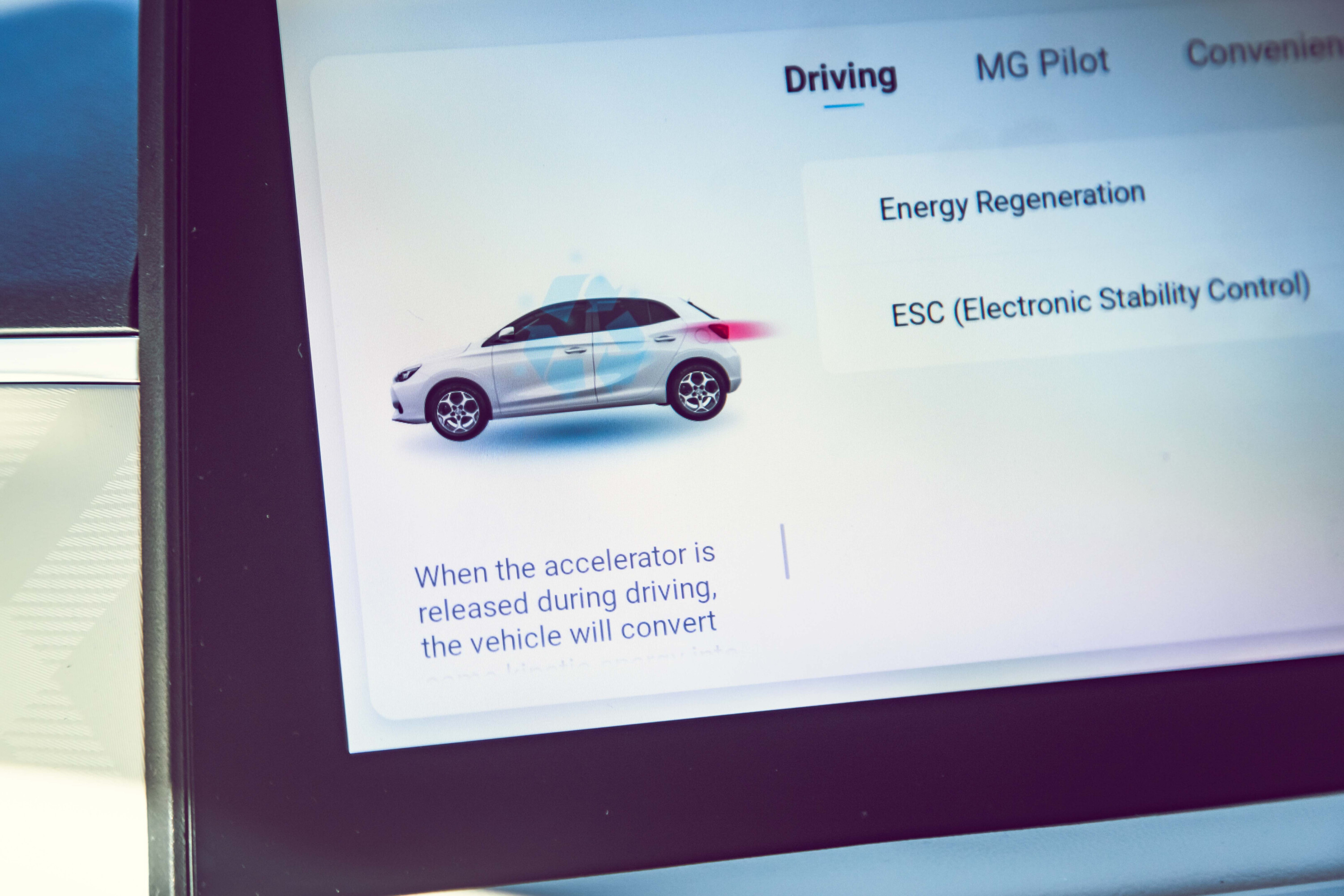
Most dimensions also grow, if not by a margin that pushes the MG3 out of ‘Light car’ territory. Six centimetres are added to its length, with five of those coming in the wheelbase, though it’s still only a touch over 4.1 metres long – shorter than one of the smallest of ‘Small cars’, the VW Golf.
The biggest stretch is to width, the MG3 widening by nearly seven centimetres – complemented by a 4cm widening of the rear track. Height is the only dimension with a minus sign against it, though the drop is a mere 2mm.
No surprises underneath. It’s struts up front, with a torsion-beam rear suspension.

Cabin space and comfort
A quick door-shut test immediately bodes well for build quality; no tinniness often associated with a budget car but instead a satisfying, Golf-like thunk.
To use another, more pertinent VW comparison, the MG3 isn’t quite Polo-posh inside but the interior has matured nicely – particularly in the case of the top-spec hybrid.
The Essence brings a full-leather steering wheel and extra pleather for the dash and seats (the latter of which look smart in the white-with-black trim option), working with other stylish materials such as the ceramic-like ultra-smooth plastic used on the centre console and dash to elevate the interior above ‘cheap car’ status.
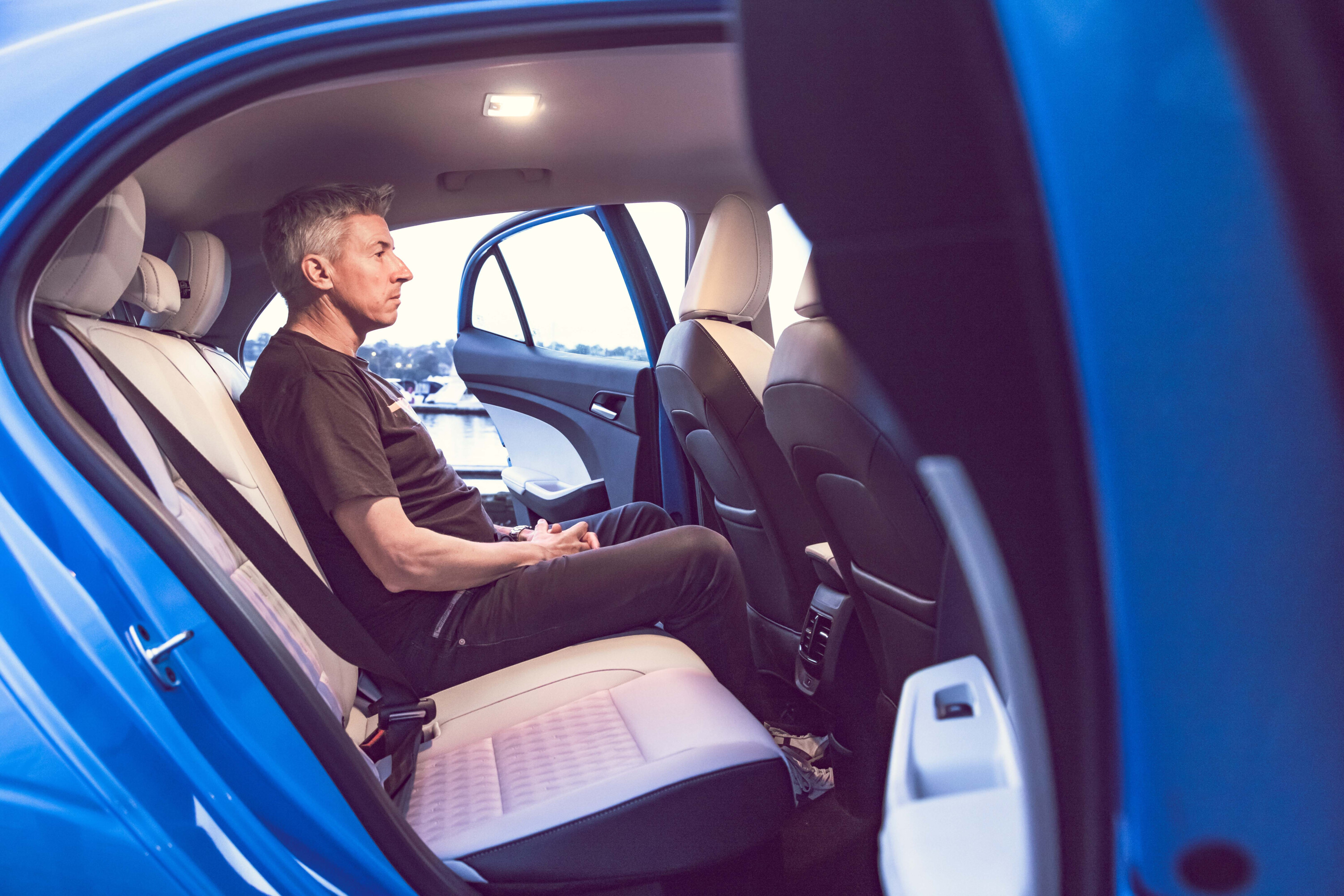
While they help offset the still-significant percentage of hard plastics, there’s impressive smoothness to the various part joins in the cabin – no rough-to-the-fingers misalignments that can be common to lower-priced cars.
Cost-cutting measures exist besides any material choices. The most obvious and surprising is a steering wheel that adjusts for height but not reach, which forces some drivers to make some compromises to the driving position. For this writer, that meant my wrists falling a bit short of being able to rest on top of the steering wheel (while stationary) to ensure my legs had the ideal distance to the pedals.
Only the driver’s window has auto up/down where the others are auto-down only, and the sliding smartphone tray on the centre console feels quite loose (at least on our test car). And, talking of mobiles, there’s no wireless charging even on this range-topper.

That tray at least contributes to some excellent front-cabin storage.
The dash layout with its dual digital displays shares some similarities with MG4, as does the Hybrid’s rotary transmission controller (petrol models have a regular auto gearlever).
The MG3’s 10.3-inch infotainment display sits lower and more naturally on the dash than in the company’s electric hatchback.
It’s a good screen size that trumps the 8.0 and 9.0 displays in the Yaris and Swift, respectively.
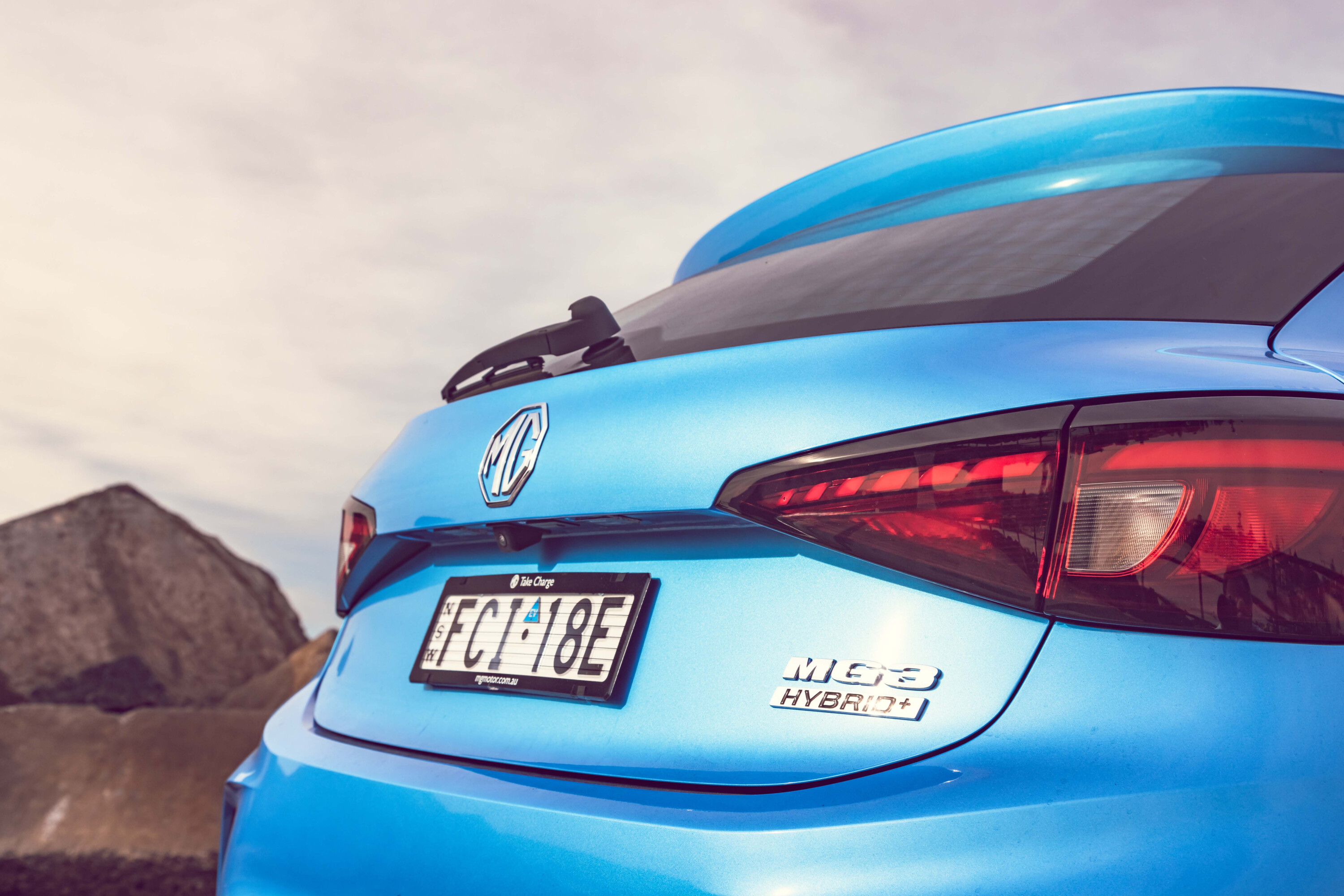
If not lent the most inspiring of visuals with mostly black/white menus with some blue thrown in, menus and functions are easily identified, and the screen response is faster than we’ve experienced with the MG4’s system.
There are physical shortcut buttons below, importantly including fast climate control access – unless, however, you’ve plugged in your phone for Apple CarPlay or Android Auto.
The steering wheel, another shared item with the MG4, includes functions that aren’t all immediately obvious, requiring some familiarisation – though this includes two star-icon buttons that can be handily configured as shortcuts to certain functions via the infotainment screen.
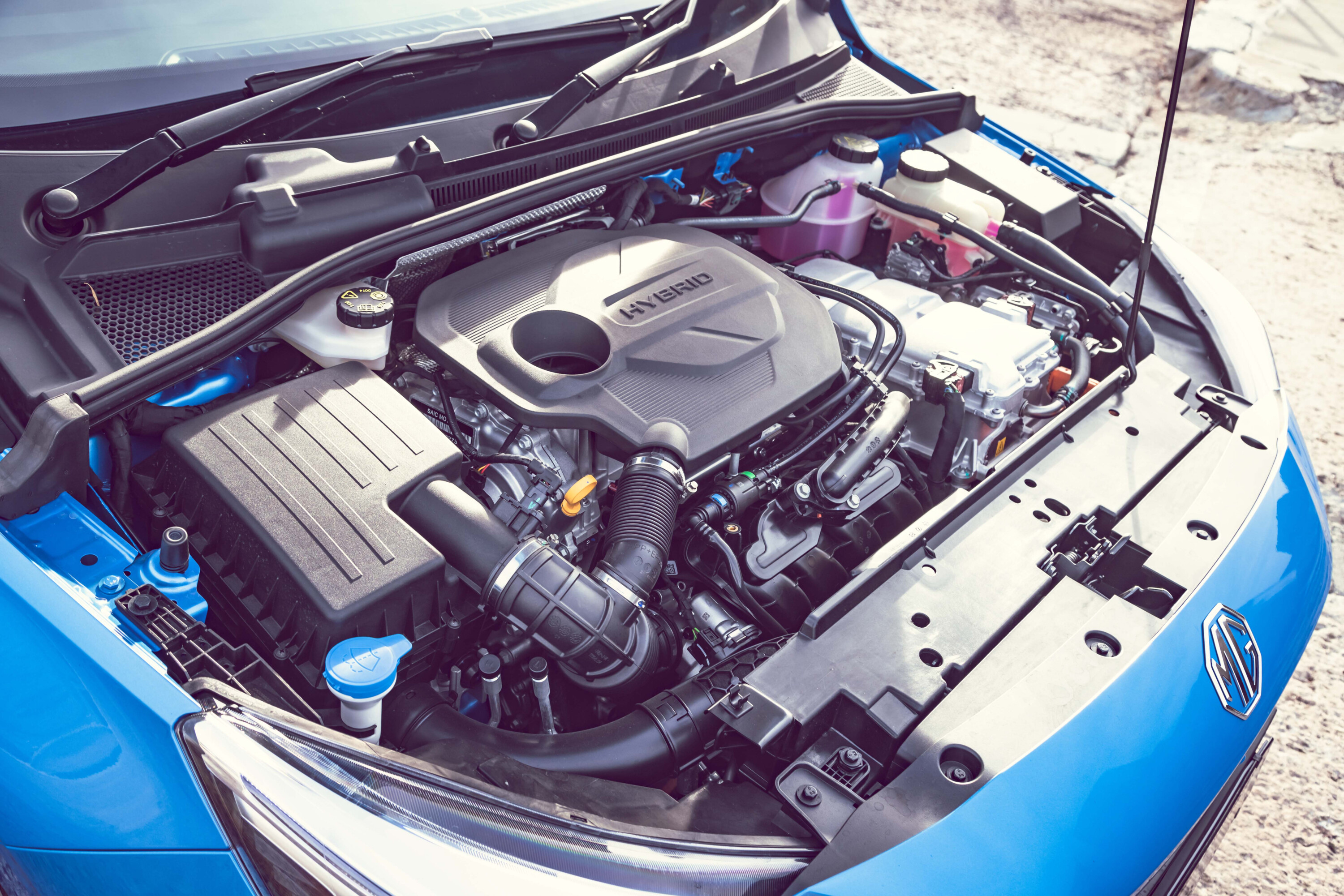
MG has done a good job on the overall cabin packaging. There’s a good amount of knee space for a regular-height adult behind their own driving position, while headroom seems sufficient for people up to six feet tall.
There’s a comfy, nicely sprung bench, too, with a long cushion good news for those with longer legs. Rear vents are also something of a rarity in a vehicle of this size.
No centre armrest also means no cupholders in the rear, only bottle holders moulded into the doors, and storage is otherwise limited to seatback pouches and a small tray just below a USB-C port.
Undamped grabhandles can be labelled as a very minor cabin-budget victim.
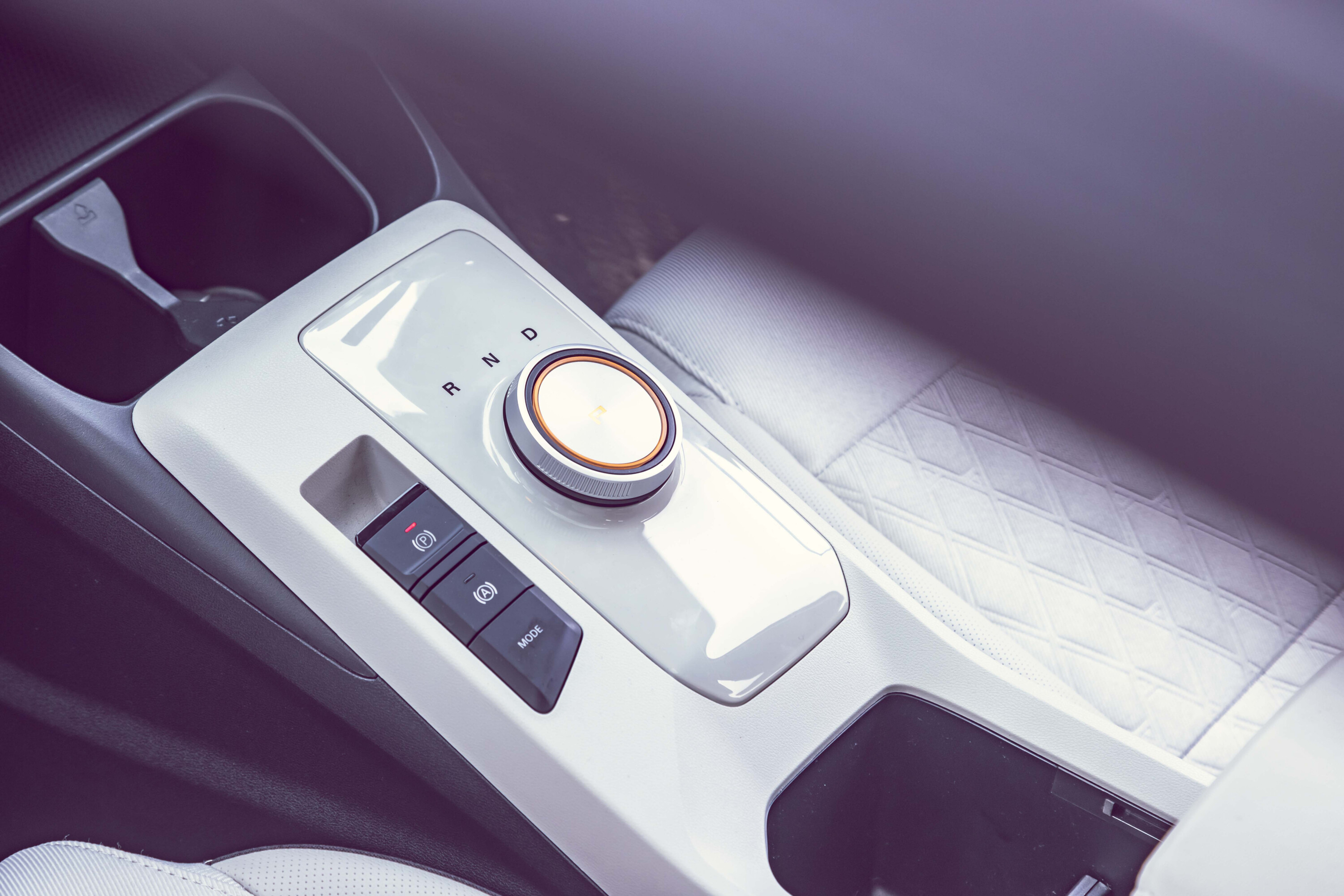
Boot capacity drops by 14 litres to 293 litres. If further distancing luggage space from the Polo’s 351L, the MG3’s volume still beats the Yaris (270L) and Mazda 2 (250L).
That increases to 983L with the rear seats taken out of action, though surprisingly the MG3’s seatback is a single piece rather than the ubiquitous 60-40 split-fold.
Hybrid models miss out on the petrol’s space-saver spare wheel under the floor, owing to the standard 12V car battery being booted out of the engine bay to make room for the electric motor.
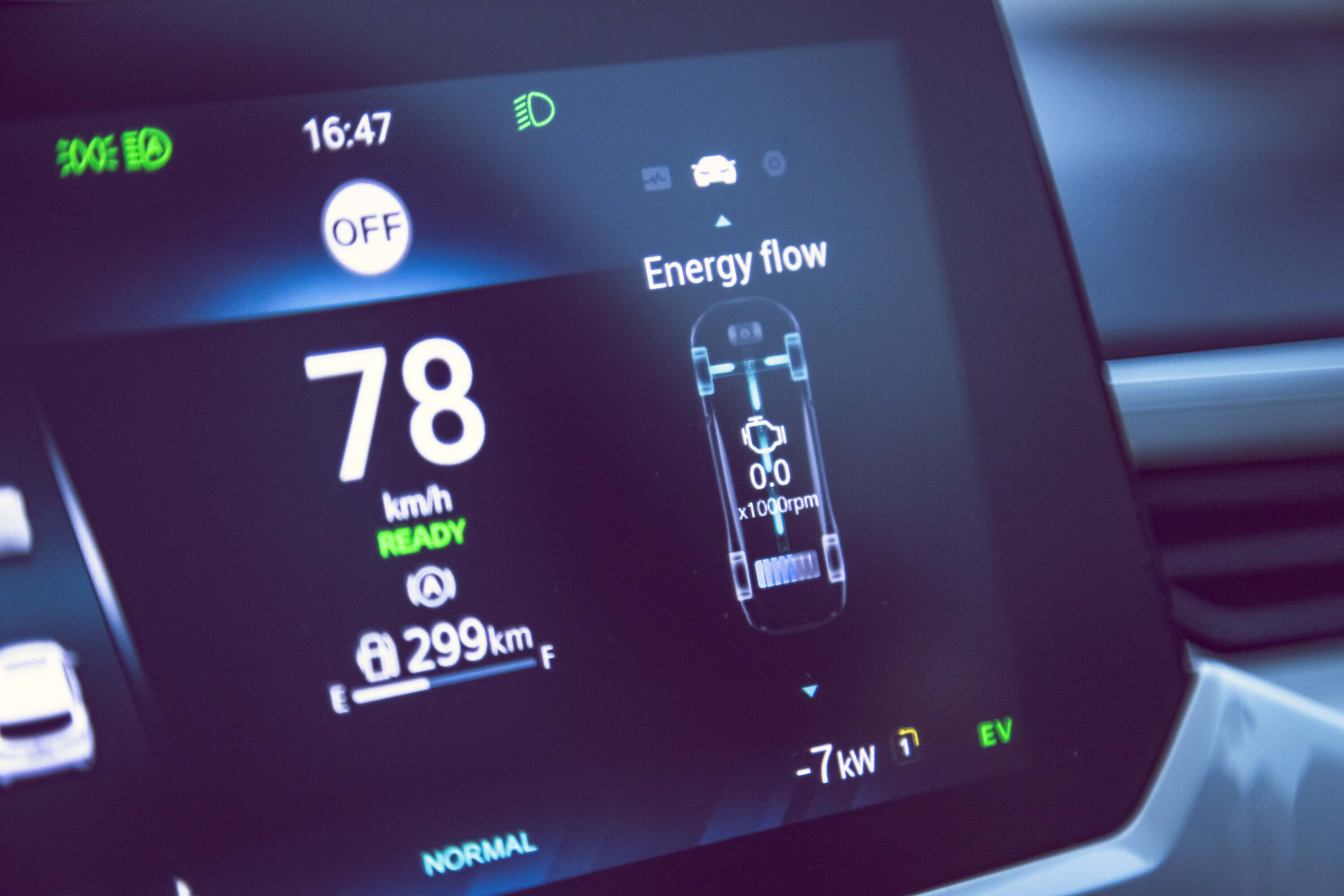
On the road
We’re yet to test the petrol-only MG3, but for reference it features a new four-cylinder engine with the same 1.5-litre displacement. Power is down fractionally from 83 to 82kW and torque drops from 150 to 142Nm, but official fuel economy improves from 6.7 to 6.0 litres per 100km.
The Hybrid+ promises even better consumption. Call that 28 percent better: 4.3L/100km.
Despite a fuel tank that’s nine litres smaller than the petrol’s (36 v 45L), the hybrid offers an extra 87km of theoretical range (837 v 750km).
The combustion half of the petrol-electric equation is also a 1.5-litre four-cylinder, and like the Yaris hybrid’s 1.5L three-cylinder it favours the economy-focused Atkinson Cycle over the more widely used Otto Cycle. It’s quoted 41 percent thermal efficiency even bests the Toyota’s, albeit it by just a single percent, though more relevant to buyers is the Yaris’s official consumption that, on paper, is a whole litre lower (3.3L/100km).
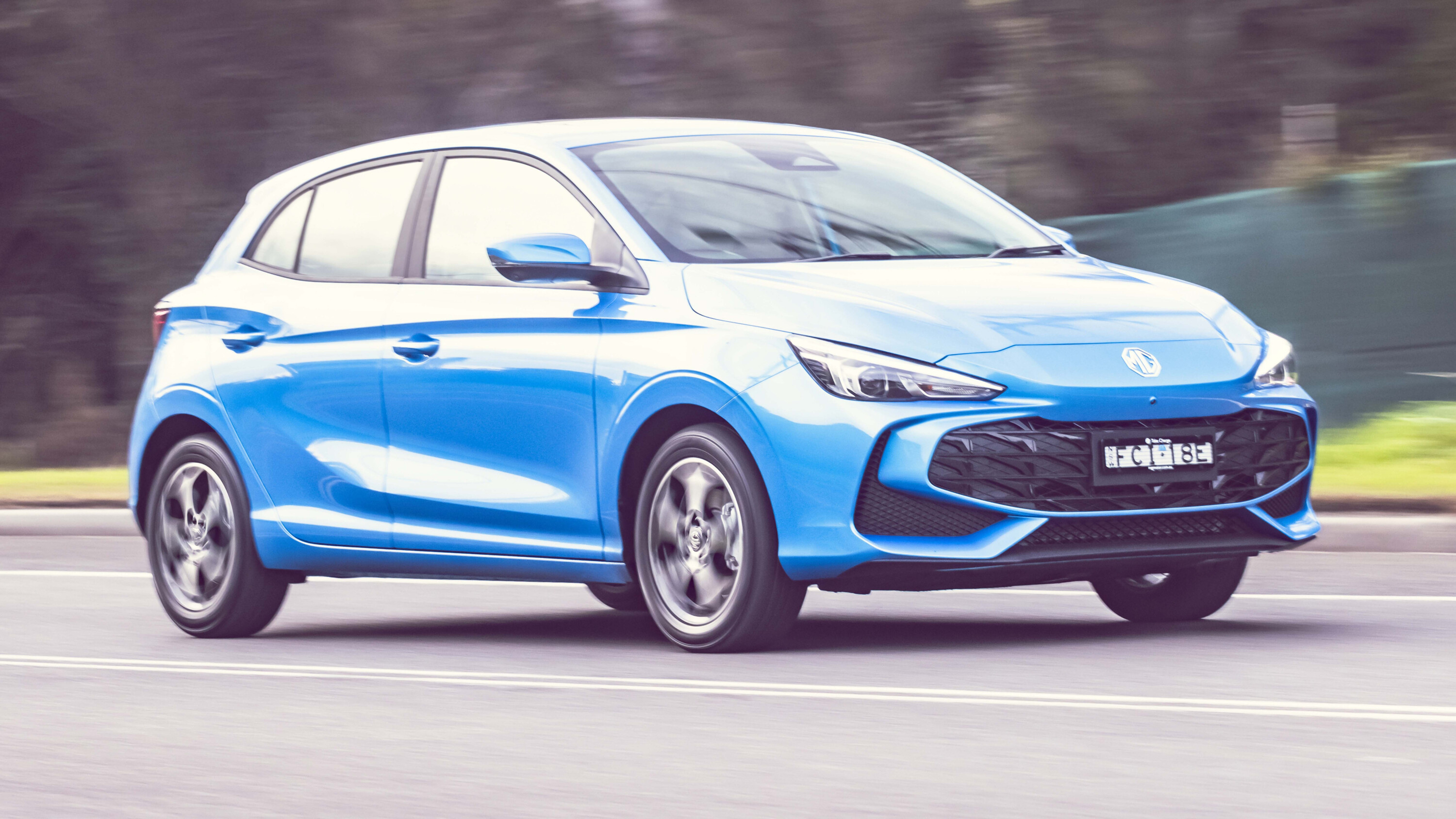
Also in the Yaris’s favour (and that of the MG3 petrol) is an ability to run happily on 91 Octane where the MG3 Hybrid+ requires 95 at a minimum.
MG’s approach to hybrid drivetrains seems a little different beyond its requirement for higher-grade fuel, though…
With a 75kW petrol engine partnered with a 100kW electric motor, combined power is a pocket-rocket-like 155kW.
MG’s specs list 8.0 seconds for the 0-100km/h acceleration run, yet arguably more impressive is a 5.0sec claim for 80-120km/h. That’s not hanging around.
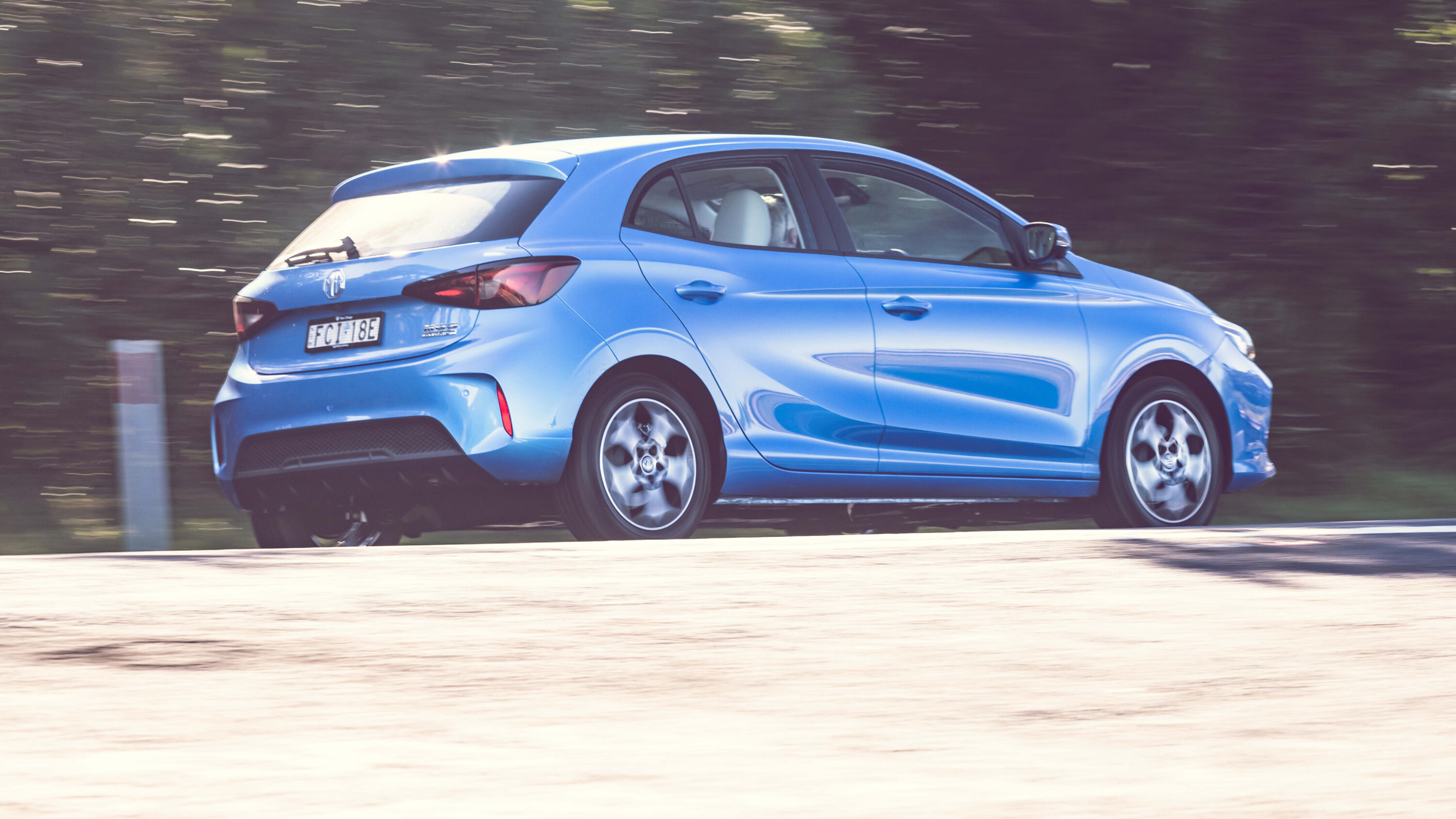
With the Hybrid’s exclusive drive modes cycled into Sport for full dual-motor goodness and a firm stomp of the accelerator pedal, we wouldn’t dispute the figure, such is the MG3’s energetic in-gear burst (in one of only three gears, by the way).
In wetter conditions, the traction control is asked to step in if accelerating from 40-45km/h with mild aggression.
If performance isn’t as punchy as the 155kW stat suggests, it still surprises for an everyday city car that isn’t aiming to become the next Ford Fiesta ST.
Eco and Normal are other driving modes, though only the MG3’s electronics control which parts of the hybrid drivetrain work and when.
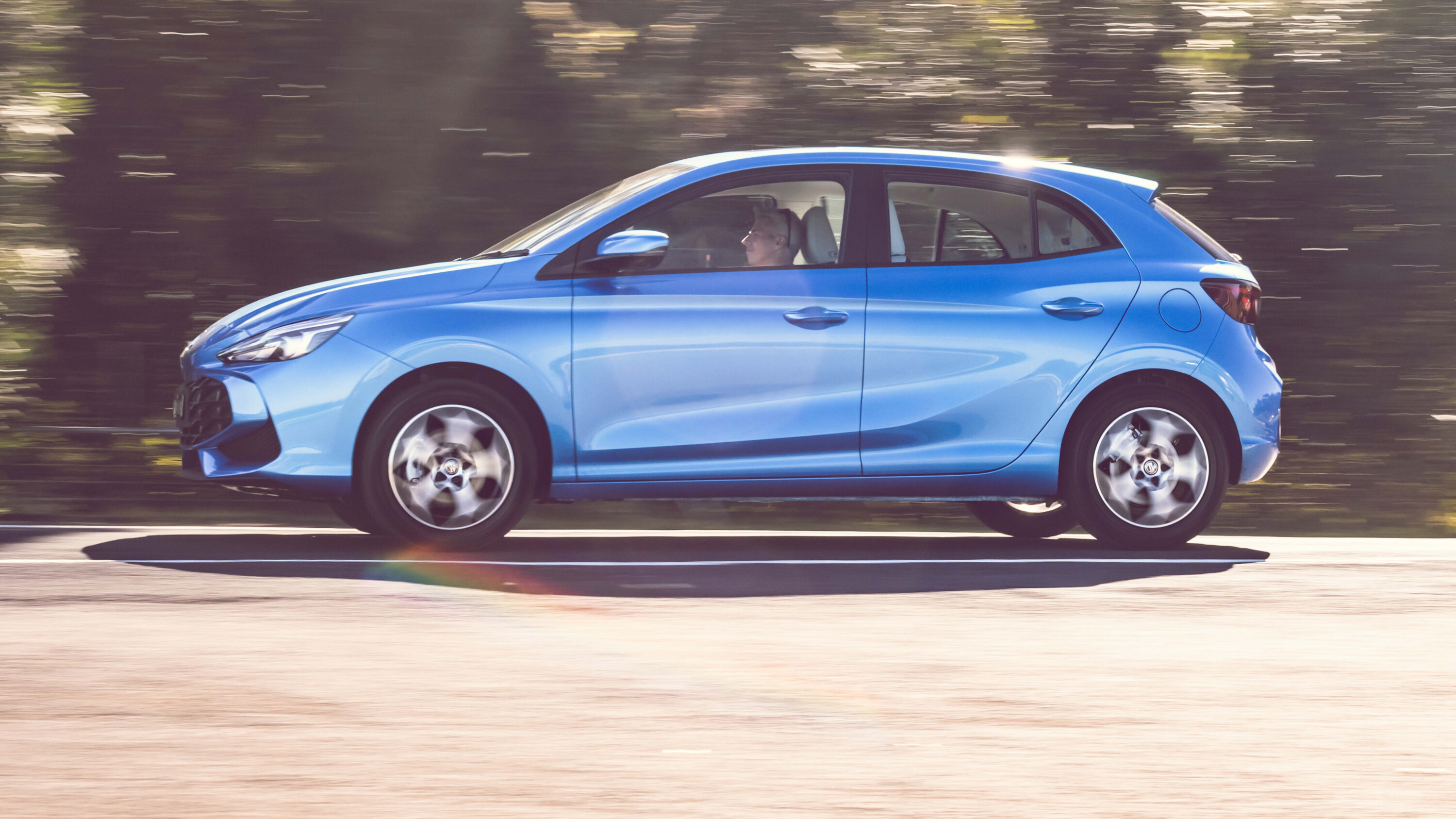
If the 1.87kWh battery has sufficient charge, the Hybrid+ will drive the front wheels with electric power only – and for faster and longer than a Yaris would typically allow.
It’s an MG4-Lite experience as there are inevitably limitations to the EV phase of motoring. The petrol engine will often fire up, with higher revs for the prevailing road speed indicating it is driving the generator that helps replenish the battery rather than helping to propel the car. The engine sometimes kicks in when the MG3 is stationary to do the same.
An Energy Flow monitor is available on the driver cluster, though it’s a shame the fascinating active diagram isn’t available in a larger size via the central touchscreen.
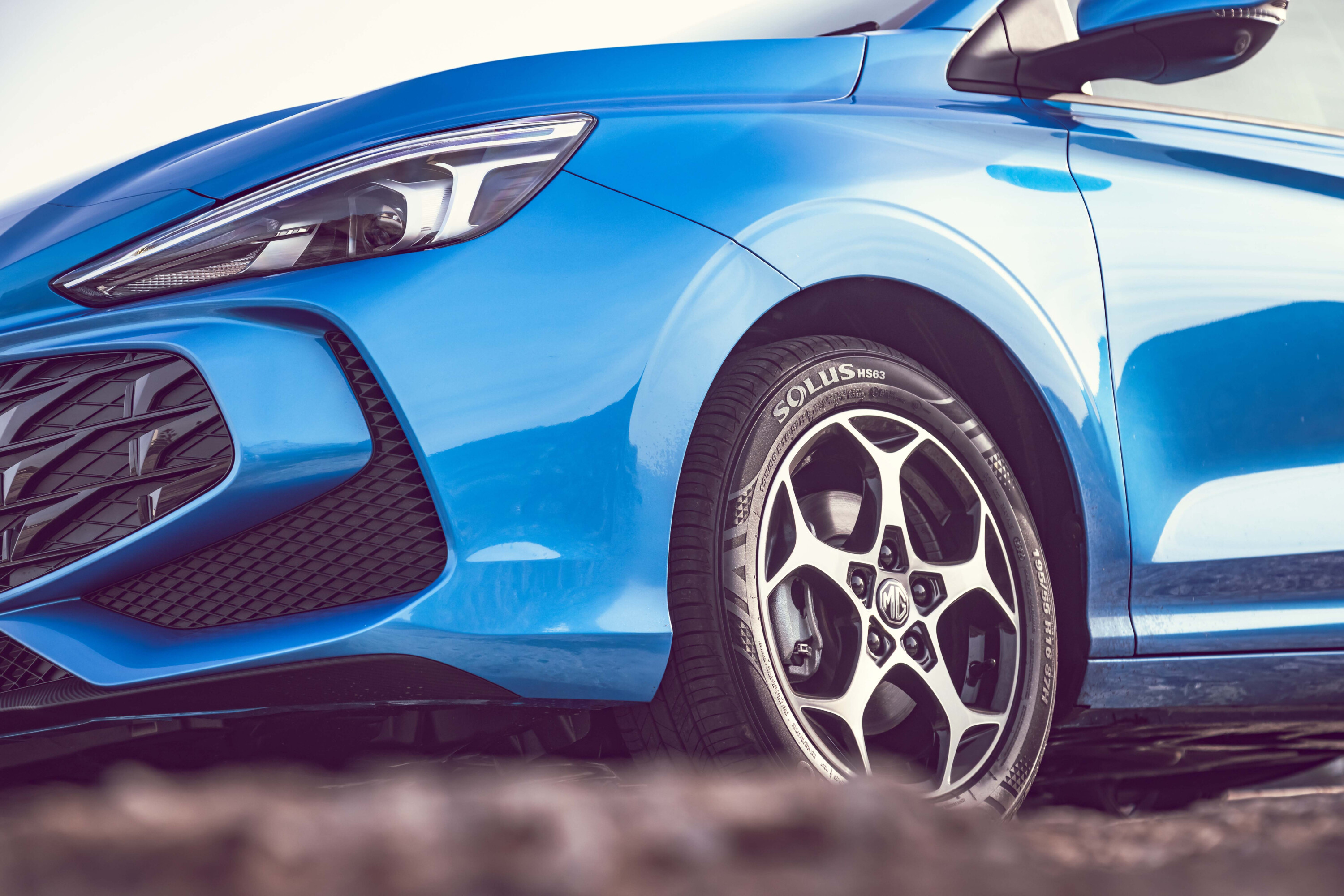
‘EV’ and ‘HEV’ modes feature permanently on the cluster as an alternative guide, the latter illuminating whenever the petrol engine is engaged for either powering the generator or wheels.
Regenerative braking is offered in three settings. High hints at the one-pedal driving offered by the MG4 without bringing the MG3 to a full stop and is best for the stop-start nature of urban driving. On the open road, Low enables more natural coasting when lifting off the throttle pedal where High, and even Medium to an extent, makes for jerkier progress.
We chose Regen-braking adjustment as one of our steering wheel shortcuts because of its ability to have either a positive or negative effect on the MG3 driving experience.
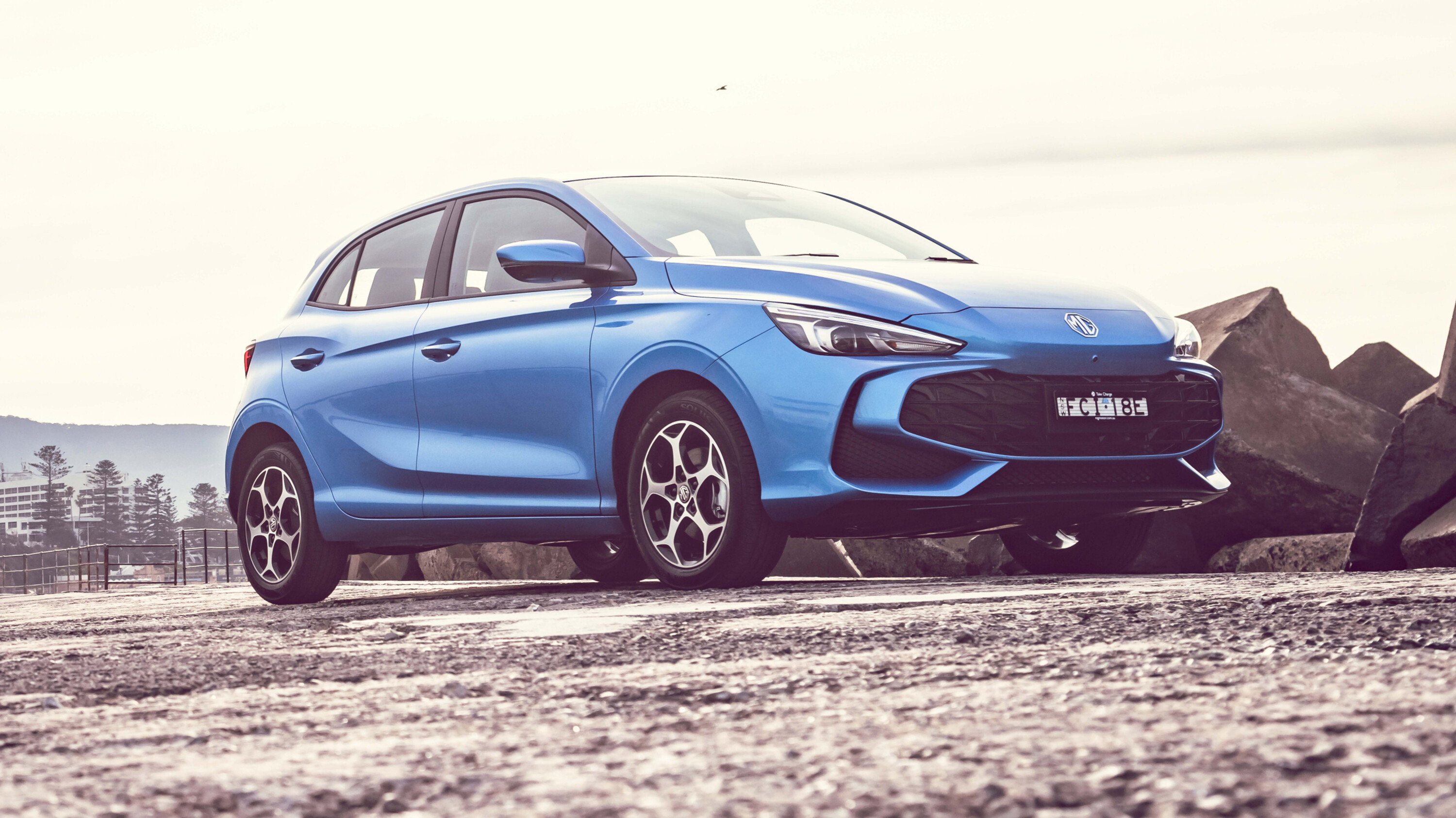
We found that was still the case with adaptive cruise engaged, prompting us to turn it off for a smoother drive on the freeway.
Turning off the Intelligent Speed Assist was also essential for our personal sanity. Essentially a speed-limit notification system combined with a speed limiter warning, it chimes every time you creep just over the prevailing speed limit. As with many other manufacturers, the system unfortunately defaults to ‘on’ every time the car is switched off and on again.
Our main drive and photography day took us from Mascot (Sydney) to the Gong (Wollongong), providing a tenuous M-G angle but also a great city-to-city run.
The MG3’s trip computer indicated a 4.8L/100km average after a total 222km drive across seven hours, with an average speed of 32k/h. Intriguingly, after a reset and 119km of pure suburban driving over multiple days, we registered an average of 7.0L/100km. Is this a hybrid that is possibly more efficient on the open road than around town, the reverse of traditional expectation?

Suburbia is where the MG3 shines brightest, though – showcasing its tight turning circle, wieldy low-speed handling, quick access to bursts of acceleration to fill traffic gaps, and a satisfyingly supple ride (further aided by its chubby 55-profile tyres).
Sharper bumps such as road joins are the only small chink in the suspension’s armour.
Although the nicely cushioned and controlled ride remains outside city limits, the rest of the MG3’s dynamics start to falter as speeds rise and roads bend.
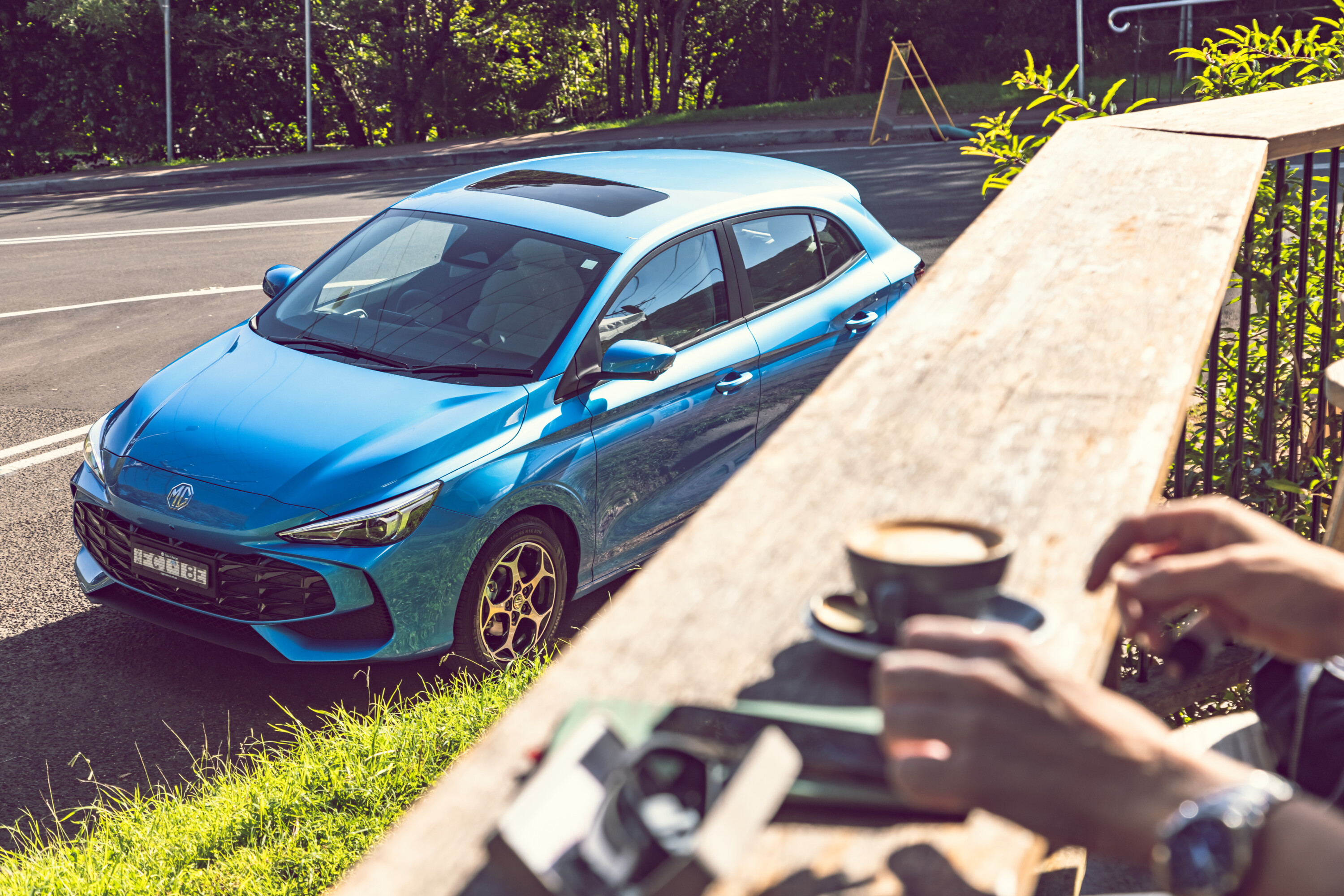
The steering is the primary letdown, its on-centre feel and response becoming vague above 60km/h – making it harder to thread the MG3 accurately along a country road or necessitating the driver to stay busy with the wheel trying to keep the car tracking straight in its freeway lane.
It’s ultimately not as endearing to keen drivers as the outgoing Swift or the dearly departed Ford Fiesta.
That said, an X-Power version of the MG3 to rival the Polo GTI would be more than welcome.
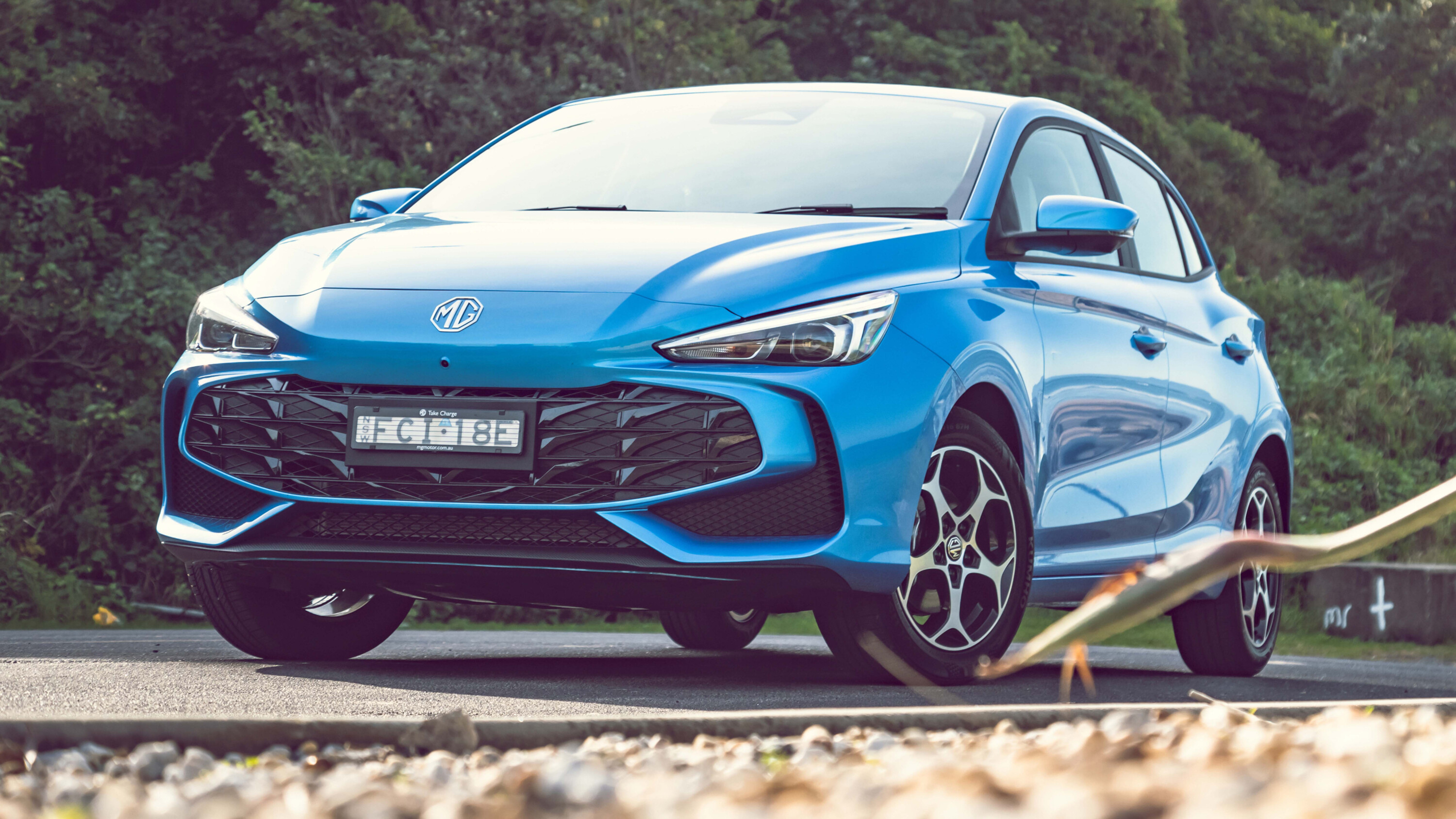
VERDICT
The MG4 – our Wheels Best EV Under $80,000 – reset expectations for future MG models.
Our hope was that the MG3 would carry plenty of that electric hatch’s strong DNA while being mostly differentiated by having a petrol engine under the bonnet as well as an electric motor.
In many respects that’s the case, while the hybrid also offers a ride even better suited to Australian roads.
If various quirks, patchy steering, and a question mark against everyday fuel economy pull the MG3 up short of small-car brilliance, still noteworthy is the giant leap over its predecessor to become a solid and highly likeable city-car package that’s far easier to recommend.
| 2024 MG3 pricing (RRPs) | |
|---|---|
| MG3 Excite petrol | $23,990 |
| MG3 Essence petrol | $25,990 |
| MG3 Hybrid+ Excite | $27,990 |
| MG3 Hybrid+ Essence | $29,990 |
Things we like
- Surprisingly brisk performance
- Supple, cushioned ride
- Good interior space for the vehicle size
- Build quality of our test car
- Nimble around town including tight turning circle
Not so much
- Real-world fuel economy higher than expected & premium fuel
- No reach adjustment for steering wheel
- Steering becomes vague at higher speeds
- Jerky and reactive adaptive cruise system
- Speed limit chime
We recommend
-
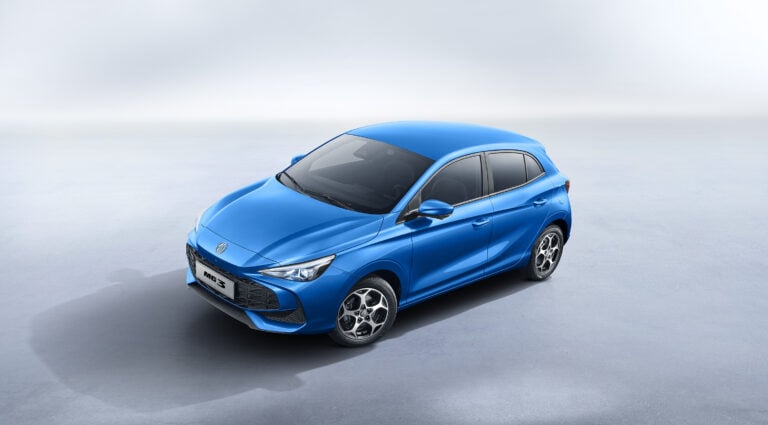 News
News2024 MG3: First UK reviews
The all-new second-generation MG3 has been tested overseas ahead of its scheduled Australian arrival later this year. Here’s what the UK media thought of the the new hatchback after driving it for the first time.
-
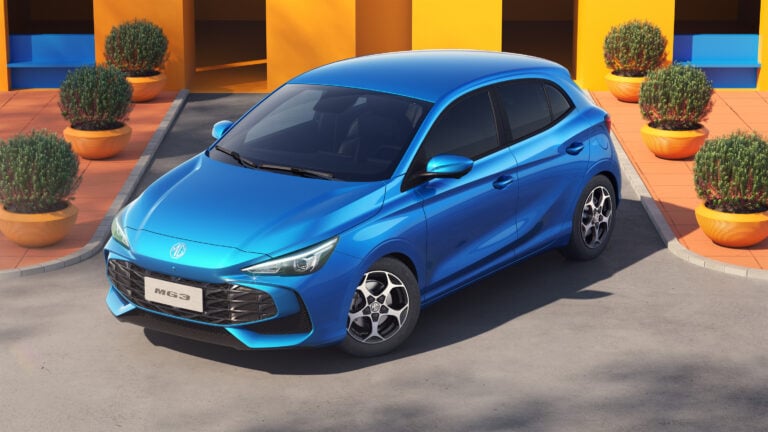 News
News2024 MG3 revealed: First new model in 13 years won’t be Australia’s cheapest new car
MG Australia has confirmed the all-new MG3 hatch will receive a 25 per cent price rise when it arrives in local showrooms later this year
-
 News
NewsNew car calendar 2026: All the new cars coming to Australia next year
Here’s the WhichCar by Wheels guide to all the new cars that will launch in Australia in 2026. Check back in regularly for updates...


